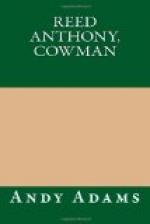Our cook was a negro. One day as we were nearing Buffalo Gap, a number of big bulls, attracted by the covered wagon, approached the commissary, the canvas sheet of which shone like a white flag. The wagon was some distance in the rear, and as the buffalo began to approach it they would scare and circle around, but constantly coming nearer the object of their curiosity. The darky finally became alarmed for fear they would gore his oxen, and unearthed an old Creedmoor rifle which he carried in the wagon. The gun could be heard for miles, and when the cook opened on the playful denizens of the plain, a number of us hurried back, supposing it was an Indian attack. When within a quarter-mile of the wagon and the situation became clear, we took it more leisurely, but the fusillade never ceased until we rode up and it dawned on the darky’s mind that rescue was at hand. He had halted his team, and from a secure position in the front end of the wagon had shot down a dozen buffalo bulls. Pure curiosity and the blood of their comrades had kept them within easy range of the murderous Creedmoor; and the frenzied negro, supposing that his team might be attacked any moment, had mown down a circle of the innocent animals. We charged and drove away the remainder, after which we formed a guard of honor in escorting the commissary until its timid driver overtook the herd.
The last of the buffalo passed out of sight before we reached the headwaters of the Concho. In crossing the dry drive approaching the Pecos we were unusually fortunate. As before, we rested in advance of starting, and on the evening of the second day out several showers fell, cooling the atmosphere until the night was fairly chilly. The rainfall continued all the following day in a gentle mist, and with little or no suffering to man or beast early in the afternoon we entered the canon known as Castle Mountain Gap, and the dry drive was virtually over. Horsehead Crossing was reached early the next morning, the size of the herd making it possible to hold it compactly, and thus preventing any scattering along that stream. There had been no freshets in the river since June, and the sandy sediment had solidified, making a safe crossing for both herd and wagon. After the usual rest of a few days, the herd trailed up the Pecos with scarcely an incident worthy of mention. Early in November we halted some distance below Fort Sumner, where we were met by Mr. Loving,—who had gone on to the post in our advance,—with the report that other cattle had just been accepted, and that there was no prospect of an immediate delivery. In fact, the outlook was anything but encouraging, unless we wintered ours and had them ready for the first delivery in the spring.




